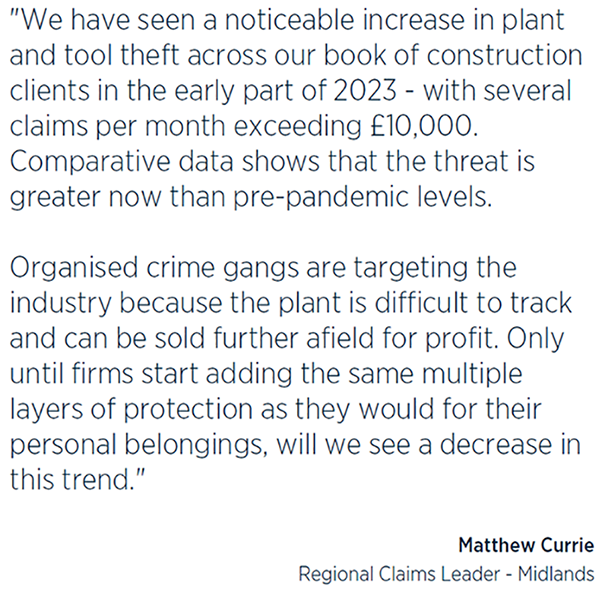An analysis of the most pressing concerns based on insights from 1,000 UK business leaders.
Author: Matthew Currie

Construction sites have long been targets for thieves due to their valuable equipment, materials and vehicles, with opportunist theft and organised crime among the methods commonly used.
According to the Construction Equipment Association, there was a 50% increase in construction site crimes during the pandemic as sites shut down abruptly and/or reduced their security personnel. With ongoing supply chain challenges and rising costs still affecting the industry, theft from construction sites continues to be a significant problem.

The consequences are numerous—the loss of vital equipment, the enforced downtime, potential damage to the site or machinery, and the unexpected costs of hiring equipment to meet project deadlines. A further headache, of course, is the potential for increased insurance premiums.
How can construction companies strengthen their defences?
By taking a proactive approach to risk management, construction companies can significantly reduce the risk of theft. We have outlined some of the action points that you can take to protect your construction site, equipment and machinery.
Site security
- Perimeter security: Erect sturdy fences, gates and barriers around the construction site to act as an initial deterrent to potential thieves. The perimeter should be well-lit and regularly inspected for any damage/vulnerabilities.
- Access control: Restrict entry to authorised personnel through controlled access points such as swipe cards or biometric systems.
- Surveillance systems: It is advisable to invest in active CCTV for sites considered to be high-risk as this method uses analytic cameras that alert a monitoring centre if the cameras detect movement on the site out of hours, allowing police to be called immediately if appropriate. Thermal imaging cameras can also be used, which reduce the number of false alarm events, as they use body heat monitoring rather than detecting movement.
- Security personnel: Hiring trained security guards to patrol the construction site during non-working hours ensures a physical presence and immediate response to any security breaches.
- Assistance from the community: Use signage to encourage the local community to report suspicious activity in or around the construction site.
Equipment and materials
- Asset tracking: Employ GPS or RFID (radio frequency identification) tracking systems on expensive equipment and materials to allow real-time monitoring and aid in the swift recovery of stolen equipment.
- Secure storage: Provide secure storage facilities, such as lockable containers or cages, for valuable tools and materials when not in use.
- Vendor screening: Conduct thorough background checks on vendors and subcontractors to help ensure their legitimacy and trustworthiness.
- Marking and inventory management: Identification marks on equipment, and a detailed and up-to-date inventory can help identify stolen items and aid in their recovery. The Construction Equipment Security and Registration Scheme (CESAR) uses multi-layered security marking which acts as a significant deterrent against theft as this method of identification is practically impossible to remove. CESAR-marked machines are more than twice as likely to be recovered as unmarked equipment.
- Hired equipment: Only hire in equipment that is installed with immobilisers and a tracking device, and has CESAR or micro CESAR marking.
Vehicle security
- Vehicle tracking: Install aftermarket GPS tracking devices in less obvious places in construction vehicles to enable additional real-time monitoring and quick recovery. Manufacturers tracking devices are often found in the same place on each vehicle, so thieves know where to locate and disable. Having an additional tracker elsewhere could help in the recovery of stolen property.
- Secure parking: Encourage employees to park construction vehicles in secure, well-lit areas with restricted access.
- Key management: Implement strict key control measures such as limiting access to keys and smart keys, and storing them securely (for smart keys, use a signal-blocking box/pouch).
- Vehicle immobilisers and CESAR marking: These can both be effective methods to make vehicles less attractive to criminals and CESAR marking can aid in recovery.
- Record evidence of your vehicles: Take photographs of your vehicles and record serial numbers. CESAR gives each machine a unique identity, which can be used for stock control, billing and service scheduling.
Employee training and awareness
- Security protocols: Clearly communicate security protocols and guidelines to all employees, ensuring they understand the importance of theft prevention and their individual responsibilities.
- Reporting mechanisms: Establish a confidential reporting mechanism to encourage employees to report any suspicious activities or potential security breaches promptly.
- Regular training: Conduct periodic training sessions to update employees on the latest theft prevention techniques and security measures.
All of these elements can work together to foster a culture of security, protect the company’s assets and uphold its reputation.
If you would like to discuss your site security, please contact Gallagher’s Risk Management team. We can conduct an assessment of your current arrangements, and provide recommendations to help improve your security and lower your risk of theft.




